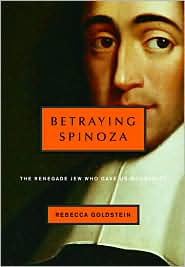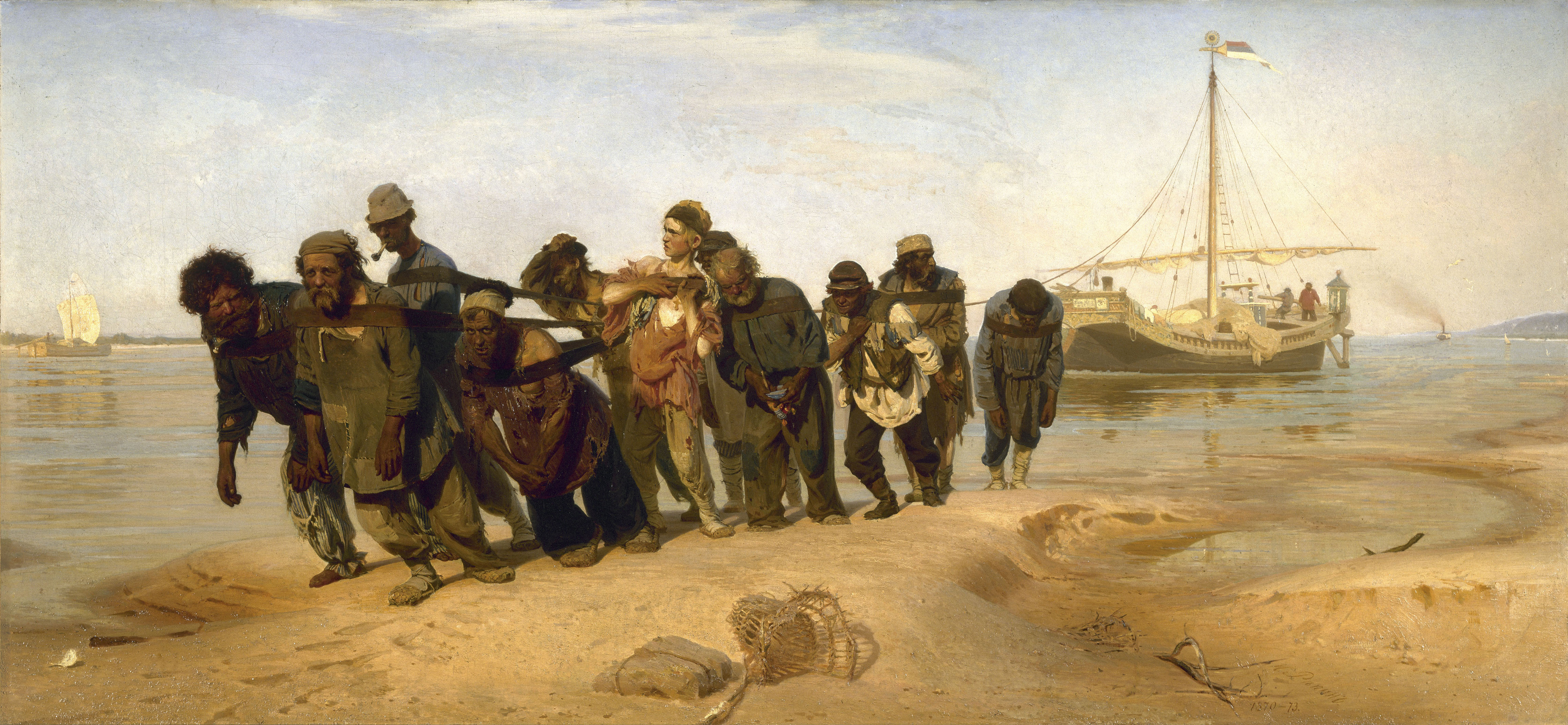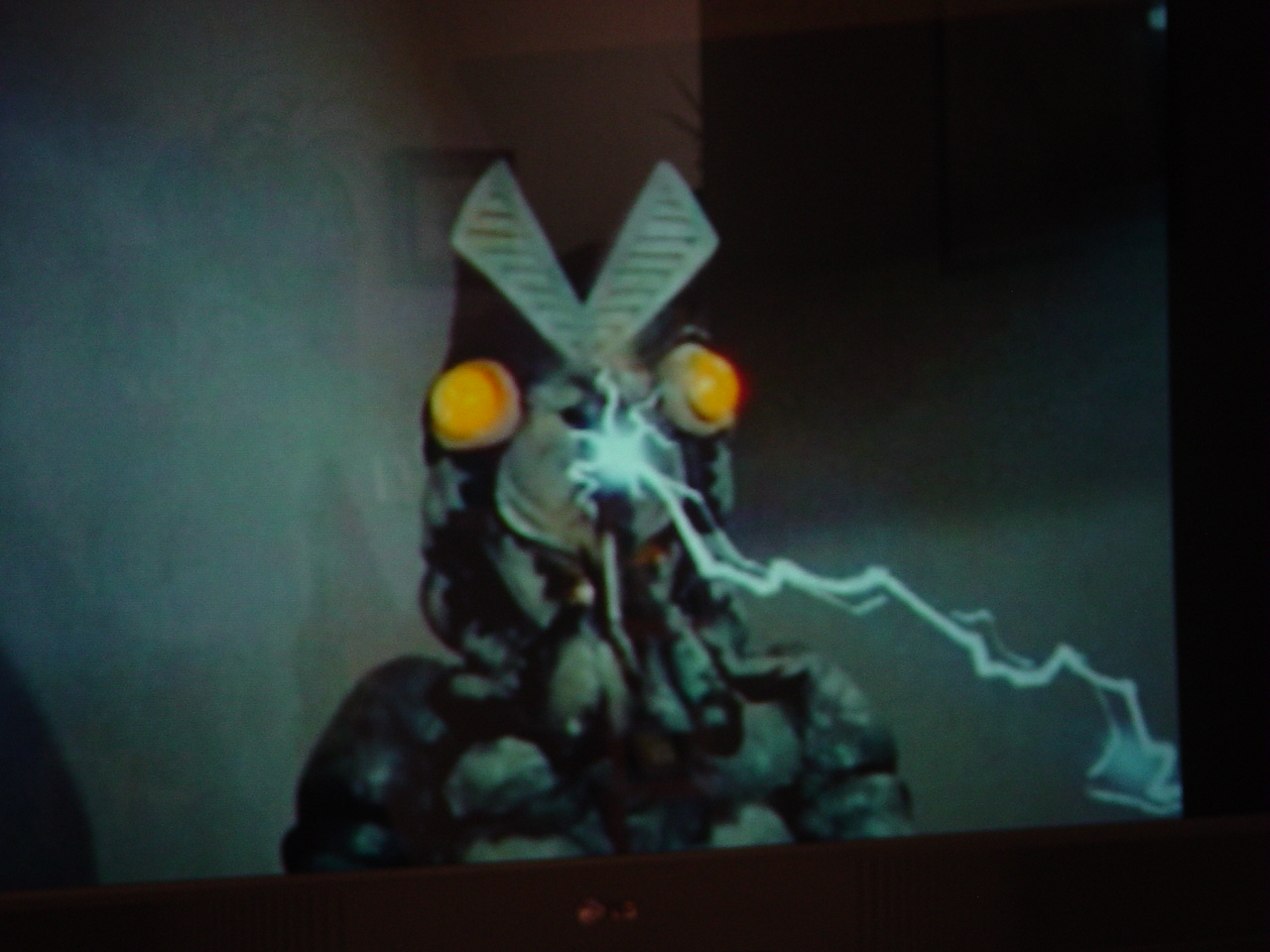"Tonight I say, we must move forward, not backward! Upward, not forward! And always twirling, twirling, twirling towards freedom! Enjoy this eight-minute Simpsons election parody from 1996. Lyndon LaRouche was right!
Sunday, August 31, 2008
Saturday, August 30, 2008
Betraying Spinoza
 This wonderful book is neither an introduction to nor truly a biography of Spinoza. It does not put forth his system of thought in any comprehensive way. It makes little comparison between Spinoza and his contemporaries. It virtually ignores his place in philosophy from an historical viewpoint. Yet it engages the reader from its first pages and it left me wishing the book had been twice as long.
This wonderful book is neither an introduction to nor truly a biography of Spinoza. It does not put forth his system of thought in any comprehensive way. It makes little comparison between Spinoza and his contemporaries. It virtually ignores his place in philosophy from an historical viewpoint. Yet it engages the reader from its first pages and it left me wishing the book had been twice as long.The book is largely presented as a parallel memoir. Baruch "Benedict" Spinoza, a 17th Century son of the Jewish exile community of Amsterdam goes from child-prodigy to excommunicate-heretic by the time he is 23 years old. Our author learns the cautionary tale of Spinoza the "epicure" as a young girl getting a conservative Jewish education in 20th Century New Amsterdam, (i.e., NYC) only to come to be a professor of philosophy whose favorite subject is none other than Benedict the Apostate himself. The author delves deep into the backroom politics of the ex-Marrano congregations of his era. We get excursions upon kabbalah, upon the Sephardic/Ashkenazic division, upon the Messianic cult of Shabbetai Zevi. Yet more contemporary and familiar thinkers like Nietzsche and Ayn Rand are mentioned - only to be dismissed. We learn that Spinoza disagreed with Descartes - but exactly over what? Nevertheless one must sympathize with the author, any work must have its limits.
I absolutely loved and adored this book. But before reading it I had already read Spinoza in an upper level philosophy course. I had studied Latin and Greek, logic and calculus, Aristotle, Aquinas and Maimonides. I fear that anyone who approaches this title as light reading, or who doesn't already know the meaning of 'axiom', 'kherem', or 'sub specie aeternitatis' may be somewhat lost. Likewise, the initiated may be expecting something more esoteric or synthetic than they will get here.
Spinoza is not an easy subject, and if there were an easy introduction to him, he would not be what he is. My best advice would be that if you are familiar with most of the terms or people I've mentioned above, and read voraciously, then buy this book without hesitation.
Friday, August 29, 2008
Ilya Repin "Pictures at an Exhibition"
 While contemplating the serene and pastoral works of William-Adolphe Bougereau reminds me of the musical work of Ralph Vaughan Williams, especially his Fantasia on Greensleeves, looking at the paintings of the Russian romantic realist Ilya Repin reminds me of the Russian composer Modest Mussorgsky's grand and tempestuous Pictures at an Exhibition.
While contemplating the serene and pastoral works of William-Adolphe Bougereau reminds me of the musical work of Ralph Vaughan Williams, especially his Fantasia on Greensleeves, looking at the paintings of the Russian romantic realist Ilya Repin reminds me of the Russian composer Modest Mussorgsky's grand and tempestuous Pictures at an Exhibition. Repin, a native of Ukraine who lived from 1844 to 1930, had a long and storied career. Painting in a colorful and dramatic style, he illustrated themes from religion, Russian history and Slavic myth, painted scenes of courtly life and of the common people, still-lifes and portraiture of great skill, and became a propagandist for revolution, the object of a Soviet cult in the 1930's.
Repin, a native of Ukraine who lived from 1844 to 1930, had a long and storied career. Painting in a colorful and dramatic style, he illustrated themes from religion, Russian history and Slavic myth, painted scenes of courtly life and of the common people, still-lifes and portraiture of great skill, and became a propagandist for revolution, the object of a Soviet cult in the 1930's.He painted a portrait of Modest Mussorgsky, and it is interesting to listen to Mussorgsky's "Pictures" while looking at Repin's paintings.
Top right is the Grand Duke's Bride, a riot of color, in which we can sympathize with the duke, who has to choose between three fat scheming courtiers. Perhaps he should be decked in black, rather than yellow.

Repin's work spans the syles from classicism - Jesus Raising Jairus's Daughter from the Dead, through romanticism Sadko in the Underwater Kingdom (above) - to impressionism - Gopak Dancers. Considered a champion of the people for such works as his Volga Boatmen, below, he was not above glorifying the Czarist regime, State Council, bottom. Luckily, we need not endorse his politics to admire his skill.


Thursday, August 28, 2008
Ultraman Lives!
 The live action Sci-Fi series Ultraman was a staple of my childhood, surpassed in esteem only by Star Trek and Doctor Who. The U.S. English Language release stopped airing around 1980. I was overjoyed to find that it was finally available in a non-bootleg release. Although some of the original footage has been replaced with black and white (very minimal) and the English language version occasionally drops into Japanese due to the loss of portions of the dubbed release, the quality of this production is quite excellent.
The live action Sci-Fi series Ultraman was a staple of my childhood, surpassed in esteem only by Star Trek and Doctor Who. The U.S. English Language release stopped airing around 1980. I was overjoyed to find that it was finally available in a non-bootleg release. Although some of the original footage has been replaced with black and white (very minimal) and the English language version occasionally drops into Japanese due to the loss of portions of the dubbed release, the quality of this production is quite excellent. The story involves Hayata, the hero, (pictured in blue, below) and the other members of the "Science Patrol" the damsel Fuji, the clownish Ito (Ide), Captain Mura (Muramatsu), dependable Ayashi, and boy sidekick Hoshino. The Science Patrol is called in to investigate strange phenomena, natural and scientific disasters, and, of course, monster sightings. In the first episode, Hayata is accidentally killed by a benevolent alien who merges with Hayata in order to restore him to life. Hayata is normally human, but when danger calls (almost always in the form of a 200ft Godzilla analog, but with ingenious variations, including lobster-clawed bug men, carnivorous space algae, and abominable snow men) Hayata transforms into Ultraman, (above, shooting his signature hand ray) a giant bug-eyed red and silver bio-mechanoid, who can shoot various death rays, fly, "Shuwach!" and do amazing Sumo moves. On watching this show again as an adult after 30 years, I am struck by the show's refreshing lack of political correctness. The contrasts between the English dialog (often cynical) and the Japanese (overblown and exaggeratedly technical) are striking, and show the difference between the post-60's anti-intellectual attitude of the U.S. compared to the earnest sincerity of the Japanese.
The story involves Hayata, the hero, (pictured in blue, below) and the other members of the "Science Patrol" the damsel Fuji, the clownish Ito (Ide), Captain Mura (Muramatsu), dependable Ayashi, and boy sidekick Hoshino. The Science Patrol is called in to investigate strange phenomena, natural and scientific disasters, and, of course, monster sightings. In the first episode, Hayata is accidentally killed by a benevolent alien who merges with Hayata in order to restore him to life. Hayata is normally human, but when danger calls (almost always in the form of a 200ft Godzilla analog, but with ingenious variations, including lobster-clawed bug men, carnivorous space algae, and abominable snow men) Hayata transforms into Ultraman, (above, shooting his signature hand ray) a giant bug-eyed red and silver bio-mechanoid, who can shoot various death rays, fly, "Shuwach!" and do amazing Sumo moves. On watching this show again as an adult after 30 years, I am struck by the show's refreshing lack of political correctness. The contrasts between the English dialog (often cynical) and the Japanese (overblown and exaggeratedly technical) are striking, and show the difference between the post-60's anti-intellectual attitude of the U.S. compared to the earnest sincerity of the Japanese. I strongly recommend that English speakers listen with English audio and the subtitles (which show the contrasting original Japanese dialog) simultaneously.
I strongly recommend that English speakers listen with English audio and the subtitles (which show the contrasting original Japanese dialog) simultaneously.This show is certainly intended for children or those nostalgic for things of their childhood. As such, it is a wonderful addition to my library. I have watched all the episodes again, recalling the joy which they brought me as a child, and can't stop singing the theme song. I hope this would translate to present day children. The special effects are done with blue-screen imaging and men in plastic monster suits, but, as with Doctor Who, the plot (however minimal) and the monster concepts drive the series. Many scenes have a spookiness or poignancy which one wouldn't expect from today's merchandise-driven shows.
This is one of my least favorite episodes. The monster is meant to be clownish, the product of the imagination of a deranged man. But there are almost no other clips of the show to be found on the internet.
The series of 39 episodes is available in a two volume release, here at Amazon.
Labels:
alien,
Animation,
Doctor Who,
Japan,
science fiction,
Ultraman
Wednesday, August 27, 2008
Strange Maps
 I have always loved maps. They are abstract, conveying information like a graph, yet concrete, like a photograph, depicting a physical reality. Maps are fractal. How long is the coast of Britain? It depends what scale the maps is drawn to, the more detailed, the longer the coast. Strange Maps is a very popular blog. I first ran across it when searching for a map of Middle Earth, depicted here. Take some time and browse the maps. They can depict what is, what never was, and what might have been.
I have always loved maps. They are abstract, conveying information like a graph, yet concrete, like a photograph, depicting a physical reality. Maps are fractal. How long is the coast of Britain? It depends what scale the maps is drawn to, the more detailed, the longer the coast. Strange Maps is a very popular blog. I first ran across it when searching for a map of Middle Earth, depicted here. Take some time and browse the maps. They can depict what is, what never was, and what might have been.
Tuesday, August 26, 2008
BBC Radio 4 "In Our Time" with Melvyn Bragg
 The British Broadcasting Company's Radio 4 offers its episodes of In Our Time with Melvyn Bragg free for podcast or archived download. The episodes are about three quarters of an hour long, commercial free, and deal with topics from history, science, religion, philosophy, and culture. Specific topics include the work and lives of Abelard, Kierkegaard, Camus and Yeats, range from topics as dry as the speed of light to those as sensational as Tacitus' descriptions of the lives of the emperors, and touch on such seminal matters as the unification of England under Alfred and such exotic topics the late Victorian and Edwardian novels predicting the coming war with Prussia, known to posterity as World War I. This is the link to the main archive. These are the episodes available under the history category:
The British Broadcasting Company's Radio 4 offers its episodes of In Our Time with Melvyn Bragg free for podcast or archived download. The episodes are about three quarters of an hour long, commercial free, and deal with topics from history, science, religion, philosophy, and culture. Specific topics include the work and lives of Abelard, Kierkegaard, Camus and Yeats, range from topics as dry as the speed of light to those as sensational as Tacitus' descriptions of the lives of the emperors, and touch on such seminal matters as the unification of England under Alfred and such exotic topics the late Victorian and Edwardian novels predicting the coming war with Prussia, known to posterity as World War I. This is the link to the main archive. These are the episodes available under the history category: Tacitus - The Decadence of Rome
The Arab Conquests - the 7th century new world order
The Riddle of the Sands - how Britain learned to fear the Germans
Trofim Lysenko - Joseph Stalin's chief geneticist
The Black Death - a plague on all our houses
The Enclosures - dividing the country
Yeats and Irish Politics - "a terrible beauty is born"
The Norman Yoke - 1067 and all that
The Dissolution of the Monasteries - religion in ruins
The Statue of Liberty - From France with love...
The Court of Rudolf II - the lost powerhouse of Renaissance ideas
The Charge of the Light Brigade - "All in the valley of Death rode the six hundred"
The Sassanian Empire - in the shadow of Ancient Persia
Divine Right of Kings - "there's such divinity doth hedge a king"
The Pilgrim Fathers - the original American dream
Siegfried Sassoon - the poet who survived
The Siege of Orleans - did Joan of Arc really rescue France?
Opium Wars - a conflict that was to affect British-Chinese relations for generations
Bismarck - the Iron Chancellor
William Wilberforce - the man and his legacy
Genghis Khan - founder of one of the world's largest ever land-based empires
The Siege of Constantinople - the end of a thousand years of the Byzantine Empire
The Peasants' Revolt - a lasting legacy for popular uprising?
The Spanish Inquisition - one of the most barbaric episodes in European history
The Great Exhibition - a wonder of the Victorian world
The Carolingian Renaissance - the revival of early medieval Western Europe
Catherine the Great - the Enlightened Despot of Eighteenth Century Russia
The Abbasid Caliphs - when Baghdad ruled the Muslim world.
Seventeenth Century Print Culture - piety, populism and political protest
The Oath - guaranteeing law, government and the army in the Classical world
The Peterloo Massacre - democratic protest and brutal repression
Field of the Cloth of Gold - a Renaissance entente cordiale
The Terror - when Madame Guillotine ruled France
Abelard and Heloise - love, sex and theology in 12th century Pari
Alfred and the Battle of Edington - without Alfred, no England?
The Assassination of Tsar Alexander II - did his killing cause the Russian Revolution?
The Roman Republic - what were Rome's republican ideals?
Machiavelli and the Italian City States - high politics and low cunning in the Italian Renaissance
The Venerable Bede - the father of English history
Agincourt - the real facts behind the battle.
The Odyssey - Homer's epic tale of Odysseus' return home
George Washington and the American Revolution - the most significant event in history
Babylon - the great forgotten civilisation
Tea - an empire in a teacup
China: The Warring States Period - the fiery beginnings of Chinese civilisation
The Decline and Fall of the Roman Empire
The Mughal Empire - the glory of India
The Battle of Thermopylae - battle that defined East & West
The Alphabet - its creation and development
Robin Hood - the greatest of English myths.
The East India Co - a corporate route to empire.
The Aristocracy - how the ruling class survives
The Art of War - maintaining the objective?
The Jacobite Rebellion - could it have succeeded?
Roman Britain - the effects of 400 years of occupation
The Spanish Civil War - causes and legacy
The Aztecs - looking behind the myths
Victorian Realism - how real?
Slavery and empire - were Britons also captives?
Architecture and power - imagery of imperialism
The History of Heritage - its influence on national identity
The American West - was it an "experiment of liberty"?
Bohemia - what did it mean to be Bohemian?
The Celts - what were the Celts in Britain really like?
Marriage - its various forms and the role of the State
John Milton - poet or politician?
Monday, August 25, 2008
William-Adolphe Bouguereau
 In explaining the influences for his recent painting, Venus, artist
In explaining the influences for his recent painting, Venus, artistMichael Newberry
lists among them the 1879 painting Birth of Venus by
William-Adolphe Bouguereau. One of the last and best loved of the figurative painters of the 19th Century, Bougereau's work came to languish in the popular consciousness as Impressionism and then Abstract Impressionism came to the fore.
According to Wikipedia:
Bouguereau’s works were eagerly bought by American millionaires who considered him the most important French artist of that time. But after 1920, Bouguereau fell into disrepute, due in part to changing tastes and partly to his staunch opposition to the Impressionists who were finally gaining acceptance. For decades following, his name was not even mentioned in encyclopedias.
But now, with his return to favor, at least with the public, and with such wonderful resources as Wikipedia itself, we can come to know this great artist with an ease of which neither the Victorians nor the Caesars could have dreamt, at our laptops, in our basements. To view images of his entire oeuvre, visit Wikipedia here. And this is one of my favorites, A Young Girl defending Herself Against Eros:

Sunday, August 24, 2008
My Soul is a Pack of Coyotes
 My soul is a pack of coyotes
My soul is a pack of coyotesTrying to catch a rabbit
In the field of my imagination.
My heart is a flock of seagulls sleeping on water
With fish going right under them
In every direction
Just like my bloodstream.
My body is an Encyclopedia of bones,
Every bone a different word,
Making my body the way it is.
- Jalen Thompson
This poem was written by Thompson at age 9. The form, the repeated conceit of metaphors for different parts of the body and spirit, and the concrete visual imagery give this poem striking impact.
Saturday, August 23, 2008
"Hate Can Be a Very Exciting Emotion"
Quick, which iconic 1940's film noir features a thrid-world nightclub owner, Nazis, a love affair gone wrong, a fateful airplane trip and an iconic theme song? If you said Casablanca, then you should have said Gilda, the best film of the 1940's, the one where the hero does not achieve greatness through sacrifice.
 Directed by Charles Vidor, Gilda stars Glenn Ford as Johnny Farrell, a handsome, streetwise adventurer and romantic lead who "makes his own luck." Having just ended a relationship, our hero moves to Buenos Aires as the war in Europe is coming to a close. He meets Ballin Mundson, a German expatriate with a dueling scar, who rescues him from a mugging in the opening scene. The classy and witty dialog and reparté is reminiscent of such films as the screwball comedy His Girl Friday, and the romantic drama To Have and Have Not. Originally cast for Humphrey Bogart who turned the role down, Glenn Ford's Johnny becomes the right hand man at Mundson's illegal Buenos Aires casino. Mundson, driven and unhappy, goes away leaving Johnny in charge. He returns, grinning like a fool, wed to Rita Hayworth's glorious Gilda, one of the most famous screen roles ever played. Unbeknownst to Mundson, Johnny and Gilda have a past. The three toast "Disaster to the wench that did our Johnny wrong," and murder ensues. The film is well plotted, and slyly written. Hayworth is at her best, singing in the nightclub, and, by removing just one glove, performing perhaps the most seductive striptease in cinematic history. I first saw this movie a year ago, and have watched it more than six times since. It cannot recommend it more highly. Hayworth also shines in The Lady from Shanghai, written and directed by, and starring Orson Welles, who was married to Hayworth at the time. Sadly, Hayworth found it impossible to live up to the fantasy ideal of Gilda in her life off stage. After several failed marriages, she complained that men "went to bed with Gilda, and woke up with me."
Directed by Charles Vidor, Gilda stars Glenn Ford as Johnny Farrell, a handsome, streetwise adventurer and romantic lead who "makes his own luck." Having just ended a relationship, our hero moves to Buenos Aires as the war in Europe is coming to a close. He meets Ballin Mundson, a German expatriate with a dueling scar, who rescues him from a mugging in the opening scene. The classy and witty dialog and reparté is reminiscent of such films as the screwball comedy His Girl Friday, and the romantic drama To Have and Have Not. Originally cast for Humphrey Bogart who turned the role down, Glenn Ford's Johnny becomes the right hand man at Mundson's illegal Buenos Aires casino. Mundson, driven and unhappy, goes away leaving Johnny in charge. He returns, grinning like a fool, wed to Rita Hayworth's glorious Gilda, one of the most famous screen roles ever played. Unbeknownst to Mundson, Johnny and Gilda have a past. The three toast "Disaster to the wench that did our Johnny wrong," and murder ensues. The film is well plotted, and slyly written. Hayworth is at her best, singing in the nightclub, and, by removing just one glove, performing perhaps the most seductive striptease in cinematic history. I first saw this movie a year ago, and have watched it more than six times since. It cannot recommend it more highly. Hayworth also shines in The Lady from Shanghai, written and directed by, and starring Orson Welles, who was married to Hayworth at the time. Sadly, Hayworth found it impossible to live up to the fantasy ideal of Gilda in her life off stage. After several failed marriages, she complained that men "went to bed with Gilda, and woke up with me."
What all the fuss is about:
 Directed by Charles Vidor, Gilda stars Glenn Ford as Johnny Farrell, a handsome, streetwise adventurer and romantic lead who "makes his own luck." Having just ended a relationship, our hero moves to Buenos Aires as the war in Europe is coming to a close. He meets Ballin Mundson, a German expatriate with a dueling scar, who rescues him from a mugging in the opening scene. The classy and witty dialog and reparté is reminiscent of such films as the screwball comedy His Girl Friday, and the romantic drama To Have and Have Not. Originally cast for Humphrey Bogart who turned the role down, Glenn Ford's Johnny becomes the right hand man at Mundson's illegal Buenos Aires casino. Mundson, driven and unhappy, goes away leaving Johnny in charge. He returns, grinning like a fool, wed to Rita Hayworth's glorious Gilda, one of the most famous screen roles ever played. Unbeknownst to Mundson, Johnny and Gilda have a past. The three toast "Disaster to the wench that did our Johnny wrong," and murder ensues. The film is well plotted, and slyly written. Hayworth is at her best, singing in the nightclub, and, by removing just one glove, performing perhaps the most seductive striptease in cinematic history. I first saw this movie a year ago, and have watched it more than six times since. It cannot recommend it more highly. Hayworth also shines in The Lady from Shanghai, written and directed by, and starring Orson Welles, who was married to Hayworth at the time. Sadly, Hayworth found it impossible to live up to the fantasy ideal of Gilda in her life off stage. After several failed marriages, she complained that men "went to bed with Gilda, and woke up with me."
Directed by Charles Vidor, Gilda stars Glenn Ford as Johnny Farrell, a handsome, streetwise adventurer and romantic lead who "makes his own luck." Having just ended a relationship, our hero moves to Buenos Aires as the war in Europe is coming to a close. He meets Ballin Mundson, a German expatriate with a dueling scar, who rescues him from a mugging in the opening scene. The classy and witty dialog and reparté is reminiscent of such films as the screwball comedy His Girl Friday, and the romantic drama To Have and Have Not. Originally cast for Humphrey Bogart who turned the role down, Glenn Ford's Johnny becomes the right hand man at Mundson's illegal Buenos Aires casino. Mundson, driven and unhappy, goes away leaving Johnny in charge. He returns, grinning like a fool, wed to Rita Hayworth's glorious Gilda, one of the most famous screen roles ever played. Unbeknownst to Mundson, Johnny and Gilda have a past. The three toast "Disaster to the wench that did our Johnny wrong," and murder ensues. The film is well plotted, and slyly written. Hayworth is at her best, singing in the nightclub, and, by removing just one glove, performing perhaps the most seductive striptease in cinematic history. I first saw this movie a year ago, and have watched it more than six times since. It cannot recommend it more highly. Hayworth also shines in The Lady from Shanghai, written and directed by, and starring Orson Welles, who was married to Hayworth at the time. Sadly, Hayworth found it impossible to live up to the fantasy ideal of Gilda in her life off stage. After several failed marriages, she complained that men "went to bed with Gilda, and woke up with me."What all the fuss is about:
Labels:
drama,
love,
Orson Welles,
Rita Hayworth,
Romantic
Friday, August 22, 2008
Barbara Stanwyck 1907-1990 the "Ball of Fire"
 Barbara Stanwyck, for a period during the 1940’s the highest paid actress in Hollywood, (and woman in the U.S.,) was a self-made woman, if ever there was one. Queen of the film noir, Stanwyck was known for playing tough broads, often the girlfriend of a mobster - Night Nurse, Ball of Fire - or a killer herself - Double Indemnity. Having lost her family at a young age, Stanwyck, born Ruby Stevens, grew up in Brooklyn and got her start on stage at age 13. Often described as ashamed of her lack of education, Stanwyck wasn’t all that ignorant. It was she who fought to have Jack Warner produce The Fountainhead, only to lose the part to Patricia Neal at director King Vidor's insistance. While her role in Double Indemnity with Fred MacMurray and Edward G. Robinson is often considered one of her best performances, my favorite so far has been her lead as Sugarpuss O’Shea in Howard Hawks’ 1941 Ball of Fire, written by Billy Wilder. In it she plays a familiar role, the gangster’s moll, and gets to show off her figure and her sultry voice as a nightclub performer. On the lam to avoid a “subpeeny” from the D.A.’s office, she meets Gary Cooper’s professor Potts, a befuddled doctor of English etymology, looking to complete his slang dictionary. This screwball comedy has Stanwyck first dupe and then fall for Cooper, each teaching the other about a part of life which each had been missing. Barbara steals the movie when she sings along to Gene Krupa, performing his virtuoso Drum Boogie, first with him on drums and her to the band, then him on matches and her sotto voce. Stanwyck was an actress often too big for the roles she played. (Her struggle against the constraints of a reality sometimes too small for our dreams was most passionately portrayed in her 1983 swan song, the Thorn Birds.) In Ball of Fire, a comedy with a plot, we see her as cunning, coy, fun and flustered, and always fully woman. When you watch it, keep in mind that Stanwyck didn’t pull her punches, and that she actually broke actress Kathleen Howard’s jaw in a stunt you’ll see on film. Above, Stanwyck as Stella Dallas, Below, from Ball of Fire, and Stanwyck's last on screen performance in The Thorn Birds - immortal!
Barbara Stanwyck, for a period during the 1940’s the highest paid actress in Hollywood, (and woman in the U.S.,) was a self-made woman, if ever there was one. Queen of the film noir, Stanwyck was known for playing tough broads, often the girlfriend of a mobster - Night Nurse, Ball of Fire - or a killer herself - Double Indemnity. Having lost her family at a young age, Stanwyck, born Ruby Stevens, grew up in Brooklyn and got her start on stage at age 13. Often described as ashamed of her lack of education, Stanwyck wasn’t all that ignorant. It was she who fought to have Jack Warner produce The Fountainhead, only to lose the part to Patricia Neal at director King Vidor's insistance. While her role in Double Indemnity with Fred MacMurray and Edward G. Robinson is often considered one of her best performances, my favorite so far has been her lead as Sugarpuss O’Shea in Howard Hawks’ 1941 Ball of Fire, written by Billy Wilder. In it she plays a familiar role, the gangster’s moll, and gets to show off her figure and her sultry voice as a nightclub performer. On the lam to avoid a “subpeeny” from the D.A.’s office, she meets Gary Cooper’s professor Potts, a befuddled doctor of English etymology, looking to complete his slang dictionary. This screwball comedy has Stanwyck first dupe and then fall for Cooper, each teaching the other about a part of life which each had been missing. Barbara steals the movie when she sings along to Gene Krupa, performing his virtuoso Drum Boogie, first with him on drums and her to the band, then him on matches and her sotto voce. Stanwyck was an actress often too big for the roles she played. (Her struggle against the constraints of a reality sometimes too small for our dreams was most passionately portrayed in her 1983 swan song, the Thorn Birds.) In Ball of Fire, a comedy with a plot, we see her as cunning, coy, fun and flustered, and always fully woman. When you watch it, keep in mind that Stanwyck didn’t pull her punches, and that she actually broke actress Kathleen Howard’s jaw in a stunt you’ll see on film. Above, Stanwyck as Stella Dallas, Below, from Ball of Fire, and Stanwyck's last on screen performance in The Thorn Birds - immortal!Drum Boogie, with Krupa & Cooper in Ball of Fire
The Thorn Birds
Tuesday, August 19, 2008
Citizen of the Galaxy
While usually considered one of his "juvenile" books, Citizen of the Galaxy is one of Robert Heinlein's best. A boy sold into slavery is purchased by a legless mendicant who teaches him what amounts to the rational egoism of a Stoic, a Jesuit, or perhaps a Randian. The beggar is more than he seems, and so is the boy.
 Leaving the slave planet, a world of Levantine decadence, the hero becomes a passenger on a family-owned trading spaceship where the crew speak what happens to be Finnish and live according to a two clan phratry system divided as well from outsiders, the "Fremdi." The social rules are very complex, one may not fraternize with the other clan, but when it comes time to take a wife, one may not marry within one's own clan. Heinlein does not make the fact that the ship members are Finns living according to ancient folk custom explicit, and I only figured this out after I had studied archeology and anthropology and then re-read the book after about a decade.
Leaving the slave planet, a world of Levantine decadence, the hero becomes a passenger on a family-owned trading spaceship where the crew speak what happens to be Finnish and live according to a two clan phratry system divided as well from outsiders, the "Fremdi." The social rules are very complex, one may not fraternize with the other clan, but when it comes time to take a wife, one may not marry within one's own clan. Heinlein does not make the fact that the ship members are Finns living according to ancient folk custom explicit, and I only figured this out after I had studied archeology and anthropology and then re-read the book after about a decade.
Having lived under a Middle Eastern-style despotry and aboard a clannish trading vessel with a gypsy-like attitude toward strangers, the hero then makes a transition into an British style navy where again he must learn a totally new way of life. He not only learns Western values, he learns his own birth identity and the role he can play, should he choose to, as a citizen of the galaxy.
The book is quite a broadening experience, for its hero and for the reader, and Heinlein's research and fidelity to the systems he describes is impressive. Except for the space element, the story might have been set on 19th century Earth. One of the best aspects of Heinlein "science-fiction" is that it is not alien or technology driven, but plot and character driven. Some of Heinlein's books have the flaw that they lack endings. Yet this story is fully integrated and does not disappoint. Do not be put off by the fact that the main character is an adolescent. The book is fully suitable for adults and I have read it three times. Heinlein's love for humanity, his cosmopolitan sophistication and his nevertheless unending advocacy for the superiority of universal liberal values show that Heinlein himself most assuredly deserved the title Citizen of the Galaxy.
 Leaving the slave planet, a world of Levantine decadence, the hero becomes a passenger on a family-owned trading spaceship where the crew speak what happens to be Finnish and live according to a two clan phratry system divided as well from outsiders, the "Fremdi." The social rules are very complex, one may not fraternize with the other clan, but when it comes time to take a wife, one may not marry within one's own clan. Heinlein does not make the fact that the ship members are Finns living according to ancient folk custom explicit, and I only figured this out after I had studied archeology and anthropology and then re-read the book after about a decade.
Leaving the slave planet, a world of Levantine decadence, the hero becomes a passenger on a family-owned trading spaceship where the crew speak what happens to be Finnish and live according to a two clan phratry system divided as well from outsiders, the "Fremdi." The social rules are very complex, one may not fraternize with the other clan, but when it comes time to take a wife, one may not marry within one's own clan. Heinlein does not make the fact that the ship members are Finns living according to ancient folk custom explicit, and I only figured this out after I had studied archeology and anthropology and then re-read the book after about a decade.Having lived under a Middle Eastern-style despotry and aboard a clannish trading vessel with a gypsy-like attitude toward strangers, the hero then makes a transition into an British style navy where again he must learn a totally new way of life. He not only learns Western values, he learns his own birth identity and the role he can play, should he choose to, as a citizen of the galaxy.
The book is quite a broadening experience, for its hero and for the reader, and Heinlein's research and fidelity to the systems he describes is impressive. Except for the space element, the story might have been set on 19th century Earth. One of the best aspects of Heinlein "science-fiction" is that it is not alien or technology driven, but plot and character driven. Some of Heinlein's books have the flaw that they lack endings. Yet this story is fully integrated and does not disappoint. Do not be put off by the fact that the main character is an adolescent. The book is fully suitable for adults and I have read it three times. Heinlein's love for humanity, his cosmopolitan sophistication and his nevertheless unending advocacy for the superiority of universal liberal values show that Heinlein himself most assuredly deserved the title Citizen of the Galaxy.
Labels:
Amazon.com,
Astronomy,
Book,
linguistics,
military,
Novel,
politics,
Robert Heinlein,
science fiction,
war
Sunday, August 17, 2008
25 Journeys with Christopher Hitchens
 Ralph Peters echoes Ayn Rand in advising that if you want to write, you have to read. His first suggestion is that you read Christopher Hitchens. If you'd like to read some polished literary gems, the L.A. Times has just opened up its treasury of 25 Hitchens articles from before and after 9-11 for public viewing. Topics range from Auden, Orwell and Horowitz to David Irving and the death penalty - these last two not in the same article. Read a particularly wide-ranging and informative article on the holocaust denier in The Strange Case of David Irving. Hitchens talks about the Hitler Diaries, the Nuremberg trials, and the concepts of academic negligence and evidence against interest. Like Rand, he ranges over a wide variety of subjects, not to demonstrate his own brilliance or to intimidate the reader but to show an integrated view of the life of the mind. After you enjoy this tour, travel with Hitchens on 24 other journeys here.
Ralph Peters echoes Ayn Rand in advising that if you want to write, you have to read. His first suggestion is that you read Christopher Hitchens. If you'd like to read some polished literary gems, the L.A. Times has just opened up its treasury of 25 Hitchens articles from before and after 9-11 for public viewing. Topics range from Auden, Orwell and Horowitz to David Irving and the death penalty - these last two not in the same article. Read a particularly wide-ranging and informative article on the holocaust denier in The Strange Case of David Irving. Hitchens talks about the Hitler Diaries, the Nuremberg trials, and the concepts of academic negligence and evidence against interest. Like Rand, he ranges over a wide variety of subjects, not to demonstrate his own brilliance or to intimidate the reader but to show an integrated view of the life of the mind. After you enjoy this tour, travel with Hitchens on 24 other journeys here.For an index of most of Hitchens' articles and appearances available on the web, check out http://www.hitchensweb.com/.
Tuesday, August 5, 2008
Enjoy Ralph Peters "In Depth" on Book TV
 Listen to the joyful, enthusiastic, pro-American writer Ralph Peters on CSPAN2 here. Banned from the Bush White House, called a Nazi by the Left, Peters talks about Iraq, his writing, education, and a whole slew of topics which he approaches in a positive pro-human way. Peters is a dynamic, off-the cuff speaker who maintains passion, clarity and principle while he talks. Like a less butch but no less eager Camille Paglia, he is a caffeinated pleasure. "Contrary to Neil Young, the Aztecs were not flower children." "War is about killing. Killing people. Not about making friends - with bullets." He uses analogies from physics and the accidents of colonial borders to explain terrorism, not as a cause, but as a sign of failure. He rattles off tribal names from Nigeria to Waziristan and he drops allusions from Hannah Arendt to William James like a day trader dropping bad stocks. Listen to him and enjoy.
Listen to the joyful, enthusiastic, pro-American writer Ralph Peters on CSPAN2 here. Banned from the Bush White House, called a Nazi by the Left, Peters talks about Iraq, his writing, education, and a whole slew of topics which he approaches in a positive pro-human way. Peters is a dynamic, off-the cuff speaker who maintains passion, clarity and principle while he talks. Like a less butch but no less eager Camille Paglia, he is a caffeinated pleasure. "Contrary to Neil Young, the Aztecs were not flower children." "War is about killing. Killing people. Not about making friends - with bullets." He uses analogies from physics and the accidents of colonial borders to explain terrorism, not as a cause, but as a sign of failure. He rattles off tribal names from Nigeria to Waziristan and he drops allusions from Hannah Arendt to William James like a day trader dropping bad stocks. Listen to him and enjoy.
Sunday, August 3, 2008
"Volver" 2006 Pedro Almodovar
 Growing up in a small Spanish village, Raimunda (Penelope Cruz) and her sister had long heard tales of ghosts, and of the madness visited upon the villagers by the dry East winds. Years before, their parents had died in a fire driven by this wind. Now, returning to bury their long senile and helpless aunt they hear rumours that she had survived with the aid of the ghost of their dead mother Irene (Carmen Maura). Suffering problems of their own, Irene's daughters now become the recipients of her spectral aid.
Growing up in a small Spanish village, Raimunda (Penelope Cruz) and her sister had long heard tales of ghosts, and of the madness visited upon the villagers by the dry East winds. Years before, their parents had died in a fire driven by this wind. Now, returning to bury their long senile and helpless aunt they hear rumours that she had survived with the aid of the ghost of their dead mother Irene (Carmen Maura). Suffering problems of their own, Irene's daughters now become the recipients of her spectral aid. This latest of Pedro Almodóvar's works, while superior in many ways to his last two movies, Talk to Her and Bad Education, still suffers from the same flaw they exhibited, a theme largely focused on the exploration of victimhood. Nevertheless, the film is visually brilliant, and the characters, while all victims, do for the most part overcome their travails. The film has what amounts to a happy ending, and does not suffer the morbid perversity of his two prior works. Fans of Almodóvar will want to see this movie if only for his characteristic use of brilliant color which makes each scene a chromatic adventure. Carmen Maura's "return" to the cast of Almodovar will also be a welcome treat for those who remeber her from the halcyon days of Women on the Verge of a Nervous Breakdown. While coherent and, with murder and melodrama, sufficiently interesting to keep one's attention, the story suffers from undeveloped subplots and elements such as drug use, lesbianism, and a dubbed but strikingly beautiful song by Cruz which seem to have been added in simply because these devices are what one expects from an Almodóvar movie.
This latest of Pedro Almodóvar's works, while superior in many ways to his last two movies, Talk to Her and Bad Education, still suffers from the same flaw they exhibited, a theme largely focused on the exploration of victimhood. Nevertheless, the film is visually brilliant, and the characters, while all victims, do for the most part overcome their travails. The film has what amounts to a happy ending, and does not suffer the morbid perversity of his two prior works. Fans of Almodóvar will want to see this movie if only for his characteristic use of brilliant color which makes each scene a chromatic adventure. Carmen Maura's "return" to the cast of Almodovar will also be a welcome treat for those who remeber her from the halcyon days of Women on the Verge of a Nervous Breakdown. While coherent and, with murder and melodrama, sufficiently interesting to keep one's attention, the story suffers from undeveloped subplots and elements such as drug use, lesbianism, and a dubbed but strikingly beautiful song by Cruz which seem to have been added in simply because these devices are what one expects from an Almodóvar movie.While described as a comedy, this movie did not once make me laugh, although the scene where Cruz sings "Volver" (return), unaware that her mother's ghost is listening, did move me. And another gratifying scene occurs when one of the supporting characters, dying of cancer, does the right thing on a Spanish version of the Jerry Springer show.
I bought this movie on DVD on the day it was released, and as an Almodóvar fan I enjoyed this film as a return to the form he exhibited in The Flower of My Secret his best work since the excellent Tie me up, Tie me Down (Átame). While certainly worth renting, I cannot recommend that non-afficionados spend their money to purchase this film.
Here is the studio trailer from YouTube:
Labels:
Carmen Maura,
drama,
Film,
Pedro Almodóvar,
Penelope Cruz,
Spanish
Saturday, August 2, 2008
iGoogle: Mistranslating the World One Phrase at a Time
I happened to be looking for an online dictionary when I came across the iGoogle service which offers to translate entire texts. Out of curiosity, I typed in "que será, será" - quite literally "what will be will be." The offered translation was "this match will be the decider." Can you imagine Doris Day singing that? Of course I decided to try more, so I typed in "no me digas," which means "don't tell me." The response was "I do not say." well, that's for sure! Finally, I put in "dímelo" which means "tell me (it)." The response was "give it to me straight"! I don't know whether this website is a joke on me, or on Google. (Actually, it seems to rely on translations already available on the web, since it got the Pledge of Alleiance flawlessly, when I don't even think most Enlish speakers could paraphrase it in their native tonggue.) I am reminded of the Soviet translation of Jesus's famouis "the spirit is willing, but the flesh is weak" which is rendered in Russian translated to English as "the liquor is agreeable, but the meat is decrepit." Ah, well...
Subscribe to:
Comments (Atom)